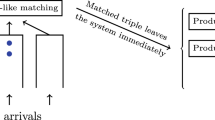Abstract
In this paper we study a system consisting of two parallel servers withdifferent service rates. Jobs arrive according to a Poisson stream and generate an exponentially distributed workload. On arrival a job joins the shortest queue and in case both queues have equal lengths, he joins the first queue with probabilityq and the second one with probability 1 −q, whereq is an arbitrary number between 0 and 1. In a previous paper we showed for the symmetric problem, that is for equal service rates andq = 1/2, that the equilibrium distribution of the lengths of the two queues can be exactly represented by an infinite sum of product form solutions by using an elementary compensation procedure. The main purpose of the present paper is to prove a similar product form result for the asymmetric problem by using a generalization of the compensation procedure. Furthermore, it is shown that the product form representation leads to a numerically efficient algorithm. Essentially, the method exploits the convergence properties of the series of product forms. Because of the fast convergence an efficient method is obtained with upper and lower bounds for the exact solution. For states further away from the origin the convergence is faster. This aspect is also exploited in the paper.
Similar content being viewed by others
References
I.J.B.F. Adan, J. Wessels and W.H.M. Zijm, Flexible assembly and shortest queue problems, in:Proc. Int. Conf. on Modern Production Concepts, Hagen, 1990 (Springer, Berlin) to appear.
I.J.B.F. Adan, J. Wessels and W.H.M. Zijm, Queueing analysis in a flexible assembly system with a job-dependent parallel structure, in:Operations Research Proceedings 1988 (Springer, Berlin, 1989) pp. 551–558.
I.J.B.F. Adan, J. Wessels and W.H.M. Zijm, An asymmetric shortest queue problem, in:Operations Research Proceedings 1989 (Springer, Berlin, 1990) pp. 434–441.
I.J.B.F. Adan, J. Wessels and W.H.M. Zijm, Analysis of the symmetric shortest queue problem, Stochastic Models 6 (1990) 691–713.
J.P.C. Blanc, On a numerical method for calculating state probabilities for queueing systems with more than one waiting line, J. Comput. Appl. Math. 20 (1987) 119–125.
J.P.C. Blanc, The power-series algorithm applied to the shortest-queue model, Memorandum 379, Tilburg University, Department of Economics (1989).
J.W. Cohen and O.J. Boxma,Boundary Value Problems in Queueing System Analysis (North-Holland, Amsterdam, 1983).
B.W. Conolly, The autostrada queueing problem, J. Appl. Prob. 21 (1984) 394–403.
G. Fayolle, Méthodes analytiques pour les files d'attente couplées, Thesis, Univ. de Paris VI, Paris (1979).
L. Flatto and H.P. McKean, Two queues in parallel, Comm. Pure Appl. Math. 30 (1977) 255–263.
G.J. Foschini and J. Salz, A basic dynamic routing problem and diffusion, IEEE Trans. Commun COM-26 (1978) 320–327.
F.G. Foster, On the stochastic matrices associated with certain queueing processes, Ann. Math. Stat. 24 (1953) 355–360.
F.R. Gantmacher,The Theory of Matrices, vol. 2 (translated by K.A. Hirsch) (Celsea, New York, 1959).
I. Gertsbakh, The shorter queue problem: A numerical study using the matrix-geometric solution, Eur. J. Oper. Res. 15 (1984) 374–381.
W.K. Grassmann, Transient and steady state results for two parallel queues, OMEGA Int. J. Mgmt Sci. 8 (1980) 105–112.
W.K. Grassmann, M.I. Taksar and D.P. Heyman, Regenerative analysis and steady state distributions for Markov chains, Oper. Res. 33 (1985) 1107–1116.
L. Green, A queueing system with general-use and limited-use servers, Oper. Res. 33 (1985) 168–182.
F.A. Haight, Two queues in paralle, Biometrica 45 (1958) 401–410.
S. Halfin, The shortest queue problem, J. Appl. Prob. 22 (1985) 865–878.
G. Hooghiemstra, M. Keane and S. Van De Ree, Power series for stationary distributions of coupled processor models, SIAM J. Appl. Math. 48 (1988) 1159–1166.
R. Iasnogorodski, Problèmes-frontières dans les files d'attente, Thesis, Univ. de Paris VI, Paris (1979).
J.F.C. Kingman, Two similar queues in parallel, Ann. Math. Statist. 32 (1961) 1314–1323.
C. Knessl, B.J. Matkowsky, Z. Schuss and C. Tier, Two parallel queues with dynamic routing, IEEE Trans. Commun. COM-34 (1986) 1170–1175.
M.F. Neuts,Matrix-Geometric Solutions in Stochastic Models (Johns Hopkins University Press, Baltimore, 1981).
B.M. Rao and M.J.M. Posner, Algorithmic and approximation analysis of the shorter queue model, Naval Res. Log. 34 (1987) 381–398.
D.R. Roque, A note on “Queueing models with lane selection”, Oper. Res. 28 (1980) 419–420.
B.L. Schwartz, Queueing models with lane selection: a new class of problems, Oper. Res. 22 (1974) 331–339.
Author information
Authors and Affiliations
Rights and permissions
About this article
Cite this article
Adan, I.J.B.F., Wessels, J. & Zijm, W.H.M. Analysis of the asymmetric shortest queue problem. Queueing Syst 8, 1–58 (1991). https://doi.org/10.1007/BF02412240
Received:
Revised:
Issue Date:
DOI: https://doi.org/10.1007/BF02412240




